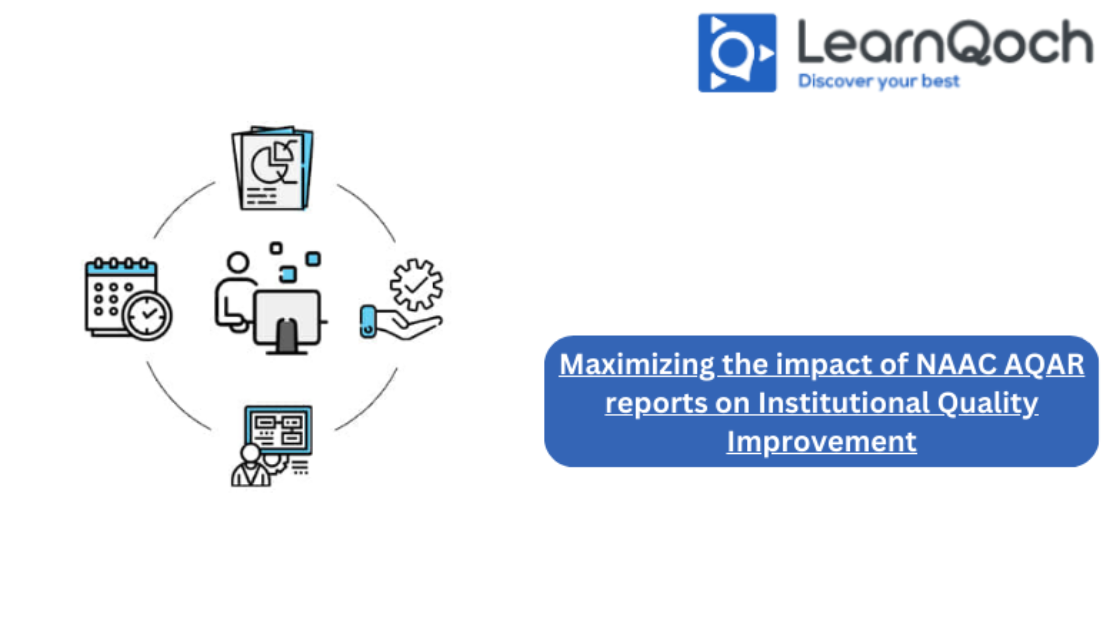Maximizing the impact of NAAC AQAR reports on Institutional Quality Improvement
The National Assessment and Accreditation Council (NAAC) AQAR report serves as a powerful tool for educational institutions to drive continuous quality improvement. By carefully analyzing the report’s findings and implementing effective strategies, institutions can maximize the impact of the AQAR report on their overall institutional development. In this blog post, we will explore key steps that institutions can take to harness the full potential of NAAC AQAR reports and foster meaningful quality improvement.
- Thorough Analysis: The first step in maximizing the impact of NAAC AQAR reports is to conduct a thorough analysis of the findings. Institutions should delve deep into the report, identifying areas of strength and weakness. By critically examining the data, institutions can gain valuable insights into their performance and identify specific areas that require improvement.
- Goal Setting: Once the analysis is complete, institutions should set clear and measurable goals based on the AQAR report’s findings. These goals should align with the institution’s vision and mission, addressing the identified weaknesses and capitalizing on the strengths. By setting SMART (Specific, Measurable, Achievable, Relevant, Time-bound) goals, institutions can create a roadmap for quality improvement initiatives.
- Action Planning: An effective action plan is crucial for translating goals into tangible outcomes. Institutions should develop a comprehensive action plan that outlines specific strategies, initiatives, and timelines for addressing the identified areas of improvement. The action plan should involve all stakeholders, including faculty, administrators, students, and support staff, fostering a collaborative approach to quality enhancement.
- Resource Allocation: To maximize the impact of AQAR reports, institutions must allocate adequate resources to support the implementation of the action plan. This includes financial resources, infrastructure improvements, faculty development programs, and technological advancements. By ensuring sufficient resources, institutions can effectively execute quality improvement initiatives and drive meaningful change.
- Implementation and Monitoring: Implementation is a critical phase in the quality improvement process. Institutions should execute the action plan in a systematic manner, ensuring that initiatives are implemented as intended. It is essential to establish a monitoring and evaluation framework to track progress, measure the effectiveness of interventions, and make necessary adjustments along the way. Continuous monitoring helps institutions stay on track and enables timely corrective actions.
- Continuous Learning and Improvement: Maximizing the impact of AQAR reports requires a commitment to continuous learning and improvement. Institutions should embrace a culture of reflection, regularly reviewing their progress, and learning from their experiences. It is essential to celebrate successes, acknowledge challenges, and continuously seek innovative solutions to further enhance quality.
- Documentation and Reporting: Institutions should maintain a comprehensive record of all quality improvement efforts, including documentation of initiatives, outcomes, and lessons learned. This documentation not only demonstrates the institution’s commitment to quality improvement but also serves as a valuable resource for future reference and sharing of best practices.
LearnQoch – ERP and LMS Software is an invaluable tool that can significantly support institutions in maximizing the impact of NAAC AQAR reports on institutional quality improvement. Here’s how LearnQoch can help:
- Data Management: LearnQoch simplifies data management by centralizing and organizing all relevant information required for the AQAR report. The software facilitates the collection, storage, and retrieval of data from various departments and stakeholders, ensuring accuracy and consistency in the reporting process. This streamlines the analysis and interpretation of data, enabling institutions to make informed decisions for quality improvement.
- Performance Tracking: LearnQoch provides performance tracking features that allow institutions to monitor their progress in relation to the goals and action plans derived from the AQAR report. The software enables the establishment of key performance indicators (KPIs) and tracks metrics related to teaching-learning outcomes, research productivity, infrastructure utilization, and more. This real-time monitoring helps institutions identify areas of success and areas that require further attention.
- Action Plan Implementation: LearnQoch facilitates the implementation of the action plan by providing project management tools and task-tracking features. Institutions can assign responsibilities, set deadlines, and monitor the progress of initiatives directly within the software. This streamlines the execution of quality improvement activities, ensuring accountability and timely completion.
4. Reporting and Documentation: LearnQoch streamlines the reporting process by generating comprehensive reports and documentation required for the AQAR report. The software offers customizable report templates and data visualization tools, making it easier to present findings, progress, and outcomes effectively. This saves time and effort in preparing the necessary documentation and ensures that institutions have well-structured and visually appealing reports for NAAC evaluation
To enhance Accreditation-related data & enhance the quality assurance standards of your institution, choose LearnQoch Software.
Call us at +91 84519 01079 or email at info@35.154.172.234
Also, read,
What is the school library system?
How to be a most preferred school in your area
How to read the minds of students to check their concept understanding daily?
The guide on Online learning platforms for schools & their benefits.




